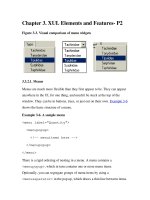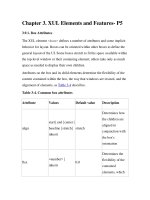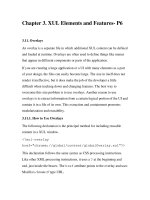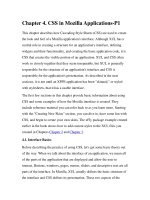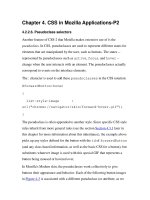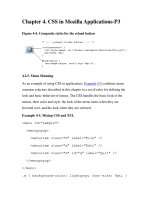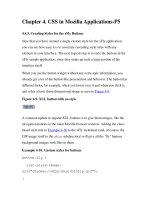Creating templates with artisteer
Bạn đang xem bản rút gọn của tài liệu. Xem và tải ngay bản đầy đủ của tài liệu tại đây (7.7 MB, 170 trang )
www.it-ebooks.info
Creating Templates with
Artisteer
Design professional-looking websites and CMS
templates, on your own!
Jakub Sanecki
BIRMINGHAM - MUMBAI
www.it-ebooks.info
Creating Templates with Artisteer
Copyright © 2013 Packt Publishing
All rights reserved. No part of this book may be reproduced, stored in a retrieval
system, or transmitted in any form or by any means, without the prior written
permission of the publisher, except in the case of brief quotations embedded in
critical articles or reviews.
Every effort has been made in the preparation of this book to ensure the accuracy
of the information presented. However, the information contained in this book is
sold without warranty, either express or implied. Neither the author, nor Packt
Publishing, and its dealers and distributors will be held liable for any damages
caused or alleged to be caused directly or indirectly by this book.
Packt Publishing has endeavored to provide trademark information about all of the
companies and products mentioned in this book by the appropriate use of capitals.
However, Packt Publishing cannot guarantee the accuracy of this information.
First published: March 2013
Production Reference: 1120313
Published by Packt Publishing Ltd.
Livery Place
35 Livery Street
Birmingham B3 2PB, UK.
ISBN 978-1-84969-941-9
www.packtpub.com
Cover Image by Suresh Mogre ()
www.it-ebooks.info
Credits
Author
Project Coordinator
Jakub Sanecki
Sneha Modi
Reviewer
Proofreader
Mark Conroy
Martin Diver
Acquisition Editor
Indexer
Mary Nadar
Monica Ajmera
Commissioning Editor
Priyanka Shah
Technical Editors
Charmaine Pereira
Graphics
Aditi Gajjar
Production Coordinator
Shantanu Zagade
Amit Ramadas
Cover Work
Copy Editors
Shantanu Zagade
Laxmi Subramanian
Ruta Waghmare
www.it-ebooks.info
About the Author
Jakub Sanecki is an experienced web developer and programmer, with over 11
years of experience. He was born in 1977 in Poland. In 2001, right before graduation
(he graduated in company management) he founded Fregata—a company where he
works until today, and took up his true passion, information technology. Starting
with providing services related to a popular ERP system, the company evolved in
the direction of programming services and custom software development. With
the increasing popularity of the Internet, it concentrated on web applications' and
websites' development. Author of many web and desktop applications, Jakub works
as an independent IT consultant and freelancer, realizing projects of various size
and complexity, for companies of various sizes. He also provides training courses
related to IT and web technologies and the techniques to use them in the company
environment. For some years he worked as a university teacher, teaching web and
desktop programming.
Fregata is an authorized reseller of Extensoft. You can visit www.szablonik.net,
as it provides support and additional information about this software tool.
Privately, a husband and father of two children, Jakub lives with his family in
Sosnowiec (in Poland), spending little moments of free time playing piano or
reading books.
www.it-ebooks.info
Acknowledgement
Almost every book starts with some words, in which the authors thank people who
have supported him/her and allowed him/her to finish the writing of the book.
Following this nice and proper tradition, I would also like to thank the people,
without whom this book would not have come into existence. First of all, I would
like to thank to my wife, Hania, who supported me all the time and forgave all my
whims while I was writing, taking care of our home and our son, and forgiving me
for spending less time with them.
I would like to thank my parents who bought me my first computers and who
always took care and trusted in me, even if my decisions seemed controversial to
them. Without their acceptance and trust, I couldn't have realized my passion and
started to make a living by founding a small IT company.
I would like to thank the rest of my family and my friends, for their patience and
understanding while I was writing, as I didn't find time to meet them.
Last but not least, I would like to thank the people from Packt Publishing, who gave
me a chance to write this book and did a great job, spending a lot of their time and
work by correcting my initial drafts and providing valuable suggestions. Without
their experience, knowledge, and commitment, I wouldn't have been able to finish
this project.
www.it-ebooks.info
About the Reviewer
Mark Conroy is a web developer and public speaker based in Galway, Ireland.
A former English teacher by profession, he began designing websites as a hobby
for friends' bands and local community groups. Since his humble beginning with
Adobe Dreamweaver, he has graduated to working, almost exclusively, with Drupal,
embracing open source technology whenever possible. As a speaker, he mostly
presents on uses of digital media for effective campaigning. He has also presented
at Drupal for Government days in Dublin on creating social networks using Drupal.
Mark is a co-organizer of the monthly Galway Drupal Meetup.
As a freelance developer working under the name A Design For
Life—www.adesignforlife.net, Mark has worked on a number of large
projects, not least of which was the redevelopment of the Ireland Reaching Out
website (www.irelandxo.com) that he built single-handedly from the ground up,
using a combination of Drupal Commons (and some extra contributed Drupal
modules), Artisteer, CSS, and CiviCRM. All functionality on the site was completed
using innovative approaches to pre-existing modules from drupal.org. He also
built and continues to maintain the political campaigns and contacts website
contact.ie, which has become the most popular online method for contacting
politicians in Ireland.
This is the first technical book Mark has worked on. He has, however, published
a textbook for English students, In Transition: An Anthology of Texts and Tasks for
Transition Year Students, is awaiting publication of a second English textbook,
and is about to start work on his third.
Mark is available for long and/or short-term freelance work, especially in
the area of Drupal and campaign technologies. You can contact him at
or
www.it-ebooks.info
www.PacktPub.com
Support files, eBooks, discount offers and more
You might want to visit www.PacktPub.com for support files and downloads related
to your book.
Did you know that Packt offers eBook versions of every book published, with PDF
and ePub files available? You can upgrade to the eBook version at www.PacktPub.
com and as a print book customer, you are entitled to a discount on the eBook copy.
Get in touch with us at for more details.
At www.PacktPub.com, you can also read a collection of free technical articles, sign
up for a range of free newsletters and receive exclusive discounts and offers on Packt
books and eBooks.
TM
Do you need instant solutions to your IT questions? PacktLib is Packt's online
digital book library. Here, you can access, read and search across Packt's entire
library of books.
Why Subscribe?
• Fully searchable across every book published by Packt
• Copy and paste, print and bookmark content
• On demand and accessible via web browser
Free Access for Packt account holders
If you have an account with Packt at www.PacktPub.com, you can use this to access
PacktLib today and view nine entirely free books. Simply use your login credentials
for immediate access.
www.it-ebooks.info
www.it-ebooks.info
Table of Contents
Preface1
Chapter 1: Meet the Artisteer
5
What is Artisteer
5
Artisteer versus other software tools
6
Who can use Artisteer8
Hobbyists8
Designers8
Web developers and programmers
9
Web development companies
9
Your first template in 10 minutes
10
Creating a new project
11
The program interface
13
The Suggestion tool
14
Previewing the project
14
Initial customizations
15
Saving the project
18
Exporting the template
20
Removing the Footnote
21
Summary22
Chapter 2: The Template Step-by-Step23
Templates23
The common parts of a website
24
Elements25
Header25
Horizontal menu
25
Vertical menu
25
Content area
25
Special blocks
25
Footer26
www.it-ebooks.info
Table of Contents
Attributes26
Page width
26
Typography27
Colors27
Layout27
Creating a template
30
Layout33
Columns and their content
36
Colors38
Background38
Pages40
Adding, removing, and renaming the pages
Page properties
40
41
Header42
Title and slogan
42
Pictures44
Shapes44
Ordering shapes and pictures
46
Flash46
Menu47
Horizontal menu
Vertical menu
Determining the pages displayed in menus
47
52
56
Content57
Writing articles
62
Inserting images
64
Inserting a slideshow
67
Typography70
Color theme
74
Footer74
Summary77
Chapter 3: CMS Templates
79
What is CMS79
Static page template versus CMS template
83
Specific CMS template elements
88
Post header icons
88
Post footer icons
89
Advanced techniques
90
Displaying positions in a Joomla! template
91
Additional template position in the header
92
Additional template positions in the footer
93
[ ii ]
www.it-ebooks.info
Table of Contents
Joomla! templates
Template Areas
Exporting a Joomla! template
Installing a Joomla! template
Setting up the template
95
96
97
98
99
Title and Slogan
Horizontal menu
Vertical menu
Footer modification
99
100
100
101
Importing content
WordPress templates
Widget areas
Exporting a WordPress template
Setting up the template
102
103
104
104
106
Title and slogan
106
Customizing the footer
106
Menus107
Importing content
107
Drupal108
DotNetNuke109
Content editing – Artisteer or CMS
109
Summary111
Chapter 4: Tips and Tricks
113
Image links in a slideshow
113
Removing the vertical menu from some pages
117
Styling a particular module
122
Styling from scratch
129
Combinations with other Artisteer-generated classes
133
Adding additional CSS to the project
134
Another way of modifying CSS files
137
Making a copy of a web page
140
Adding Lightbox
141
Summary147
Index149
[ iii ]
www.it-ebooks.info
www.it-ebooks.info
Preface
Designing good-looking, professional-quality web templates or building your
own website is a complicated task. Artisteer has changed this situation, enabling
anyone to do it by themselves, without the need to learn things such as HTML,
web-programming languages, or drawing. Creating Templates with Artisteer is
a practical, step-by-step guide that will show you how to prepare an elegant,
professional-looking website on your own, using the features of Artisteer.
This book is great for enthusiasts, Artisteer users, and individuals who want to create
professional-looking websites without paying for professional services, expensive
tools, and also to speed up the work and automate time-consuming tasks.
What this book covers
Chapter 1, Meet the Artisteer, helps you to learn what Artisteer exactly is and how
it can be useful for you. We will familiarize you with the interface and some basic
functions of the application. You will also prepare your very first template.
Chapter 2, The Template Step-by-Step, covers the typical process of designing with
Artisteer, explaining all the typical elements of the template one by one. At the
end of this chapter, you will be able to prepare your simple website all alone.
Chapter 3, CMS Templates, discusses advantages of using a content management
system (CMS) over a static website, and how to use Artisteer for designing templates
for such solutions. We will convert our example project into Joomla! and WordPress
installable packages, and also import the content from Artisteer into CMS.
Chapter 4, Tips and Tricks, shows you some additional effects you can enrich your
project with by slightly modifying the source code generated by the program.
www.it-ebooks.info
Preface
What you need for this book
In order to appreciate this book completely, we recommend you to have Version 4
of Artisteer, which can be downloaded from and
Notepad++, which can be downloaded from />
Who this book is for
This book is addressed to anyone wanting to build their private or company website
on their own, without learning technical stuff such as HTML, CSS, or programming,
and for professionals considering including Artisteer into their toolkit. It's also
addressed to all the less-advanced Artisteer users, looking for a printed guide.
Conventions
In this book, you will find a number of styles of text that distinguish between
different kinds of information. Here are some examples of these styles, and an
explanation of their meaning.
Code words in text are shown as follows: "Edit the template.css file once again
and append the following code at the end:"
A block of code is set as follows:
.customart-nostyle.MySpecialModule
{
margin-top: 0;
border: none;
}
New terms and important words are shown in bold. Words that you see on
the screen, in menus or dialog boxes for example, appear in the text like this:
"Choose the Colors & Fonts tab on the ribbon.".
Warnings or important notes appear in a box like this.
Tips and tricks appear like this.
[2]
www.it-ebooks.info
Preface
Reader feedback
Feedback from our readers is always welcome. Let us know what you think about
this book—what you liked or may have disliked. Reader feedback is important for
us to develop titles that you really get the most out of.
To send us general feedback, simply send an e-mail to ,
and mention the book title via the subject of your message.
If there is a topic that you have expertise in and you are interested in either writing
or contributing to a book, see our author guide on www.packtpub.com/authors.
Customer support
Now that you are the proud owner of a Packt book, we have a number of things to
help you to get the most from your purchase.
Downloading the example code
You can download the example code files for all Packt books you have purchased
from your account at . If you purchased this book
elsewhere, you can visit and register to
have the files e-mailed directly to you.
Errata
Although we have taken every care to ensure the accuracy of our content,
mistakes do happen. If you find a mistake in one of our books—maybe a mistake
in the text or the code—we would be grateful if you would report this to us.
By doing so, you can save other readers from frustration and help us improve
subsequent versions of this book. If you find any errata, please report them by
visiting selecting your book, clicking
on the errata submission form link, and entering the details of your errata. Once
your errata are verified, your submission will be accepted and the errata will be
uploaded on our website, or added to any list of existing errata, under the Errata
section of that title. Any existing errata can be viewed by selecting your title from
/>
[3]
www.it-ebooks.info
Preface
Piracy
Piracy of copyright material on the Internet is an ongoing problem across all media.
At Packt, we take the protection of our copyright and licenses very seriously. If you
come across any illegal copies of our works, in any form, on the Internet, please
provide us with the location address or website name immediately so that we can
pursue a remedy.
Please contact us at with a link to the suspected
pirated material.
We appreciate your help in protecting our authors, and our ability to bring you
valuable content.
Questions
You can contact us at if you are having a problem with
any aspect of the book, and we will do our best to address it.
[4]
www.it-ebooks.info
Meet the Artisteer
In this book, you will see that you are able to design and prepare a
professional-quality website template all alone, without anybody's help.
You don't need to know how to draw or how to code. You don't need to
worry about HTML, CSS, PHP, and all that complicated stuff. All you need
is your copy of Artisteer.
You may ask, "What is Artisteer?"
What is Artisteer
Artisteer is an Automated Web Designer. What does it mean? In simple words,
it's an application that lets you prepare great websites, even if you don't know
anything about drawing, programming, web technology, and all that stuff. With
Artisteer, you can design your website, fill it with content, and in the end, generate
the ready-to-use HTML/CSS files that you can upload to your web server (in fact,
this can also be done in Artisteer). You can also automatically generate any layout in
the form of a template dedicated to one of several well-known CMS systems, such
as Joomla!, Drupal, WordPress, or DotNetNuke. The design process looks totally
different in comparison to the traditional way in which it's usually done. While you
still have a lot of control and can decide many aspects of your design, the drawing
process is done automatically and doesn't demand any graphic skills from you,
except a good eye for what looks good on a page. And it's fast. Indeed very,
very fast.
Artisteer was the first application of its kind in the market and still remains one of
the best tools in this category.
www.it-ebooks.info
Meet the Artisteer
Artisteer versus other software tools
Because Artisteer is a new kind of tool, it is hard to give a proper definition of what
it is. There are a lot of easier ways to say what Artisteer is not. This will allow us
to avoid any confusion about what it should be compared with. If we consider the
typical process of building a website, it usually consists of several stages as follows:
1. Firstly, a designer prepares a design. He usually works with a graphics editor.
2. When the design is ready, it's analyzed in detail to qualify what can be
achieved with HTML/CSS, and what has to stay as pictures. Then the
whole layout is sliced into small pictures.
3. A web developer prepares the layout in the HTML language and places
every single picture into its proper position with the help of CSS. To illustrate
the look of the site and to be able to choose the appropriate typography, the
places for content are usually filled with some dummy text (for example,
"Lorem ipsum dolor sit amet…). He does this usually with a code editor.
4. The dummy text gets replaced with the target content. This task is usually
done with the help of a WYSIWYG editor. At the end of this stage, we have
a complete static website.
5. If the website should contain some more sophisticated elements, such as
photo galleries, fancy tooltips, movies, forms, and so on, or if it should be
transformed into a template for a CMS, an additional code has to be written.
This is the job of a programmer, who writes the code in a code editor using a
client-side or server-side language (according to what should be achieved).
This allocation of tasks is of course quite hypothetical, and it may vary in particular
teams and companies, but the goal was to show you the flow of the overall process.
Sometimes the entire process is done by a single person, but in the case of bigger
projects, it's not uncommon that every stage is realized by a group of people.
Therefore, we're talking about a group of people (a team of various specialists)
using different tools, such as graphics editors, WYSIWYG HTML editors, code
editors, and so on.
• Artisteer is not a graphics editor. In a graphics editor, you must design
everything by hand, while in Artisteer all the elements (for example, header,
menu, and so on) are generated automatically, according to the parameters
you set via the program's interface. Graphic editors offer sophisticated tools,
which Artisteer doesn't contain, to process pictures and photos. In a graphics
editor you can create any graphic, while in Artisteer the only thing you can
design is a website.
[6]
www.it-ebooks.info
Chapter 1
• Artisteer is not a WYSIWYG editor. In a What You See Is What You Get
(WYSIWYG) editor, you can type the words and insert the graphic elements
into a website in a similar way as you would use a word processor (for
example, MS Word) and the application automatically transforms everything
into an HTML code. The layout elements in Artisteer are not just graphics,
they are highly interactive and you have a lot of control over them. You
can resize them, change the color, border, placement, and almost any other
aspect of their look and feel. Your actions are not transformed into HTML
immediately. You work with a binary Artisteer project (.artx files), and only
when you press the Export button, the layout is exported. What it means is
that all the layout is processed in one go and the HTML/CSS/JavaScript/
PHP code is generated. But it's also true, that the way of working with
Artisteer is practically WYSIWYG—you don't see any code, but the
final design.
• Artisteer is not a code editor. You can press the Show the code button and
take a look at the HTML file that will be generated (and even change it), but
this is not the native way you will work with this application. The native
way is "point and click". In a code editor you write the code and preview the
results. In Artisteer you modify the results and preview the generated code.
• Artisteer is also not a collection of predesigned layouts, as many
people seem to think. There is no upper limit on the unique layouts that
can be created, because the answer is unlimited. It's true that the program
contains a limited number of graphics and predefined elements, for example,
menu. But the possibility of inserting your own images and determining
almost any aspect of the elements (size, colors, fonts, and so on) suggests that
you are a real designer, and not just someone who selects a template from the
predefined options.
The tools that are most similar to Artisteer are other web builder applications.
The difference is in what you can change and set up. As I mentioned earlier,
you can change almost everything in Artisteer.
[7]
www.it-ebooks.info
Meet the Artisteer
Who can use Artisteer
So who is Artisteer dedicated to? The potential audience of this program is very
large. I can't be sure, but I feel that the intention of Artisteer's creators was to create
a tool that allows the nongraphic and nontechnician people to create complete
and great-looking websites. This would place Artisteer as a tool for hobbyists and
enthusiasts, but the scope of users is much larger. Let's consider this problem from
several different points of view.
Hobbyists
A hobbyist is somebody who wants to have a website because of his/her private
passion. It's not his/her job, it's not his/her business, he/she won't gain any money
on it. It may be a private blog on Blogger or WordPress, or just a simple family
website, often based on the cheapest hosting service possible. For such a person,
hiring a professional web development company or freelancer is usually not an
option because of the cost. Usually, the only available option is to try to prepare
the page on his/her own (the results will be adequate to his/her skills), or to buy
a ready-made template (accepting the fact that there are a lot of different websites
that look the same). Artisteer gives such people a third option: buy the program and
prepare a unique and good-looking site all alone. The cost will be less than the usual
price for a ready-made, standard layout on the market.
Designers
A designer is an artistically talented person who can use the graphics editors and
create good-looking designs for web pages. In a team, a designer usually does
the first stage of work, creating an overall concept of how the site will look, and
preparing the graphics. While a designer is good at drawing, he/she can't code. To
create a website a designer needs the help of a web developer. But with Artisteer,
he/she can design the template and enrich it with his/her own custom graphic
elements, which he/she can prepare. He/she can even enter the content and
transfer this all into a CMS skin, offering the end user a complete solution.
[8]
www.it-ebooks.info
Chapter 1
Web developers and programmers
The frontier that divides web developers and programmers is often very thin, and
various companies use different names for the same jobs. In this book, we assume
that a web developer is someone with the skills for creating HTML/CSS code.
Additionally, he or she often has good knowledge of administrating the CMSs,
can install and configure various extensions, and is able to prepare the whole
website, including stylesheet modifications, as there's no requirement of individual
programming. The programmers are usually "next-level web developers", with
programming skills. Usually, they code the core of the CMS systems or its additional
functionality (create extensions). In short, we can assume that a web developer is
someone who builds websites using the things that a programmer codes.
Web developers and programmers are able to build the whole website on their own,
if not for one problem—they can't draw. They may be great technicians, but not
graphics designers, and even the most technically advanced site without graphics
does not impress anybody. That's why they often use ready-made templates as a
basis for further work. The problem arises when there is a need to modify not the
functionality, but the look of the site. In that case they have to cooperate with
the designers.
Designers are the people who have an artistic taste. They can assess what looks good
and what doesn't, even if they couldn't draw it on their own. Artisteer offers them
the possibility to design a template independently, by determining the look of the
site and its various elements, by changing their parameters such as colors, position,
size, and so on. As you will see later, working with Artisteer resembles a situation
wherein the designer is sitting next to you, listening to your suggestions, making the
changes on the fly, and presenting the results immediately.
Web development companies
One of the main reasons that people work together is that nobody is perfect, nobody
possesses all the talent. It would seem that for an individual, Artisteer may be a good
option, because it allows him to avoid cooperation (which can be costly) with other
specialists and to create the whole project alone. But in case of a team consisting of
people with different complementary skills, there's no need to use such a tool at all.
Based on my personal experience, I disagree with such a thought, and I can quote
several arguments to support my words as follows:
• The main cost factors of any work or project is always the time and the
skills required for the job to be done. Designing and programming are
very time-consuming tasks, and any automation saves time and money.
[9]
www.it-ebooks.info
Meet the Artisteer
• One of the biggest and most frustrating things in the web-design business
is that your customer usually won't pay for something that he or she hasn't
seen before. With Artisteer, the first stage of concept can really be done
very fast.
The previously discussed examples of why Artisteer can be useful for various groups
of people doesn't mean that everything can be done with Artisteer, of course. For
example, you can't add any logic to the site, as this would demand a programming
work. Similarly with the graphics, even the best automated generator won't replace
the real artist. Like with every other thing, the custom and handmade products are
the best, and websites are not an exception to this. For example, cars. Do you agree
that a representative, handmade limousine, or a sports car is better than a popular
compact from serial production? You probably do, but do you have a handmade
sports car? Millions of people everyday drive the cheap compacts to commute,
and they are pretty happy with it. Price is the factor. The same is with websites.
Your first template in 10 minutes
Ok, enough of just talking. Let's see Artisteer in action. Like in most programming
books, where the first exercise is displaying the "Hello World!" text, we are going to
create our first "Hello World!" template. So let's begin.
The program comes in two editions: Home & Academic and Standard, which
differ in functionality. The Home & Academic edition is a truncated version of
the Standard edition. In this book we work with the Standard edition.
You can download the latest version from the producer's website under the address
There is one installer for both the
versions and according to the license number you have, the Standard or Home &
Academic edition will be activated. The same installer can also be used to install the
trial version that allows you to know the program and make the decision if you want
to buy it or not.
The trial version has no time limit for usage or feature limitations. You may use it for
as long as you wish and play with all functionalities. The difference between the trial
and full versions is that the trial version doesn't allow you to save a project, and the
exported templates show the Trial watermark.
[ 10 ]
www.it-ebooks.info
Chapter 1
The installation process is fully automated, and if you accept the license terms and
don't need to install the application in a specific location, all you have to do is just
click on the Next button until the process is finished.
To transform the trial version into the full version, the application needs to be
activated. This process requires an Internet connection. To activate, click on
the Activate button shown on the welcome screen (you can also choose the
File | Activation option from the menu). You will go to the Artisteer Activation
window, where you should enter your license key into the License Key: field",
as shown in the following screenshot:
Activation window
After you have entered your license key, click on the Activate button. After a few
seconds, your copy of Artisteer will be fully activated.
Creating a new project
After you start the program, the first screen you will see is a window titled New
Project. Here you can decide whether you want to open a previously saved project,
or start a new one. The main part of this window consists of three rows. In the first
row you can filter among the available, pre-made templates (if you want to start by
modifying one of them). The pre-made templates are presented in the third row,
according to which category and sorting rule you choose.
The second row always contains only one icon. Click on it when you want to start
with a Blank template and style everything from scratch.
[ 11 ]
www.it-ebooks.info
Meet the Artisteer
In the column to the right-hand side of the window, there is a list of recently opened
projects, as in the following screenshot:
The startup window in Artisteer
You may say, "Wait a minute! You have said that in Artisteer I can design not
only static websites, but also templates for various CMSs. Where can I set up what
exactly I'm going to do?" Yes, you are right. What's more, in the previous versions
of Artisteer, there was an additional field in the startup window where you could
set it up. But with the current version, you don't have such an option. It's not a
restriction of functionality, but rather a change in the philosophy of working with
the application. You are just designing, no matter which platform you will choose
later. That's because you choose the platform at the end, not at the beginning.
It also highlights the fact that Artisteer enables you to focus on the design,
and not the platform that you choose. Think of design as something that is
platform independent.
Because we want to start with a blank template, let's click on the solitary icon in the
second row. Artisteer will load its default data. In the following steps we are going
to turn it into our custom layout.
[ 12 ]
www.it-ebooks.info
